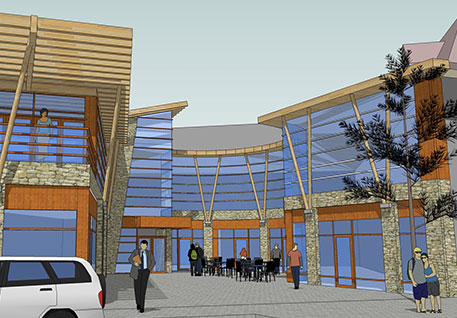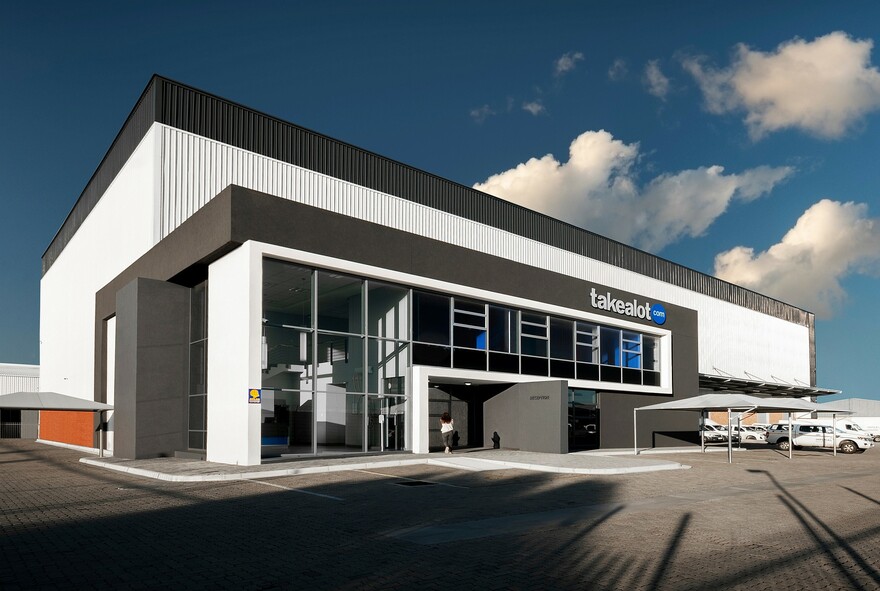Discover the Ingenious Services Offered by Commercial Architects for Your Following Project
Commercial architects play an essential role fit the developed environment. They mix capability with aesthetic appeal, developing areas that reverberate with brand identification. These specialists employ ingenious layout solutions, sustainable methods, and advanced technologies to enhance customer experiences. Their joint strategy assurances alignment with customer visions and functional needs. Nevertheless, the extent of their solutions typically extends past style. The following action in recognizing just how these architects browse complicated task demands may surprise you.
Understanding the Role of Commercial Architects
The function of commercial architects may vary depending on the certain job, their main function rotates around making functional and aesthetically attractive rooms for organizations. These experts are charged with understanding the one-of-a-kind requirements of each client, whether it be a retail store, office complex, or commercial center. They perform complete website evaluations and work together with stakeholders to ensure that the style aligns with the business objectives and brand name identity.Commercial architects also navigate different regulatory requirements, safeguarding compliance with zoning legislations and structure codes. Their experience expands to producing sustainable layouts that advertise power efficiency and environmental obligation. Additionally, they handle the project's timeline and budget plan, collaborating with specialists and engineers throughout the construction procedure. By mixing creative thinking with technological knowledge, industrial architects play an important role in changing conceptual ideas into concrete truths, eventually improving the functionality and allure of business rooms.
Cutting-edge Design Solutions for Distinct Areas
As commercial spaces significantly require distinctiveness to attract attention in open markets, cutting-edge design solutions have actually ended up being important for architects. These specialists take advantage of their creative thinking and technical knowledge to craft special environments that show brand name identity and improve customer experience. By incorporating advanced modern technology and products, industrial architects can change ordinary spaces right into bewitching venues that engage customers and inspire employees.Architects employ numerous strategies, such as adaptive reuse, which rejuvenates existing structures while protecting their historic relevance. They also discover non-traditional designs and multifunctional rooms that cater to diverse needs, ensuring flexibility for future growth.Furthermore, the consolidation of biophilic style-- bringing nature indoors-- produces inviting ambiences that advertise wellness - commercial architects. This focus to information in cutting-edge style not only addresses aesthetic worries however also promotes community and partnership. Inevitably, these customized remedies enable companies to thrive in an ever-evolving landscape, setting them aside from rivals
Sustainable Design Practices
Sustainable design methods have become a crucial emphasis for business architects looking for to create impactful designs that resonate with environmental stewardship. These techniques focus on using sustainable sources, power performance, and very little waste, mirroring a dedication to minimizing the eco-friendly footprint of structures. Architects integrate products that are sustainably sourced or recycled, ensuring that construction techniques straighten with ecological principles.Furthermore, the assimilation of environment-friendly roofs and walls boosts biodiversity while enhancing power performance. Effective water management systems, such as rainwater harvesting, add to sustainability by conserving water sources. All-natural ventilation and daylighting strategies are also used to maximize interior settings, decreasing reliance on artificial home heating and illumination.
Integrating Innovation in Architectural Layouts
A boosting variety of industrial architects are embracing innovation as a transformative aspect in building layout. By leveraging advanced software tools such as Structure Info Modeling (BIM), architects can produce in-depth 3D representations of jobs, permitting improved visualization and partnership amongst stakeholders. This innovation assists in real-time adjustments, lessening errors and streamlining the design process.Additionally, architects are integrating smart structure innovations right into their layouts, which boost energy effectiveness and owner comfort. Attributes such as automated lighting, environment control, and safety systems can be perfectly included, advertising lasting methods and reducing operational costs.The use of virtual and enhanced reality also allows clients to experience designs prior to building and construction begins, giving invaluable understandings into spatial connections and visual options. Inevitably, the combination of technology in architectural styles not just cultivates technology yet likewise ensures that jobs are carried out with precision and straightened with modern demands.

Task Monitoring and Control Solutions
Effective job management and coordination solutions are essential for the effective implementation of commercial building projects. These solutions guarantee that all elements of a task, from preliminary style to last building and construction, are seamlessly incorporated. Commercial architects play a significant role in coordinating in between different stakeholders, consisting of customers, service providers, and vendors, to preserve clear interaction and alignment on task goals.By executing structured methods, architects can handle timelines, budget plans, and sources successfully, minimizing delays and price overruns. They use task monitoring software and devices to track development, manage documentation, and assist in collaboration among group members.Additionally, these services consist of risk analysis and reduction strategies, validating possible challenges are recognized and resolved proactively. The outcome is a streamlined process that enhances general task effectiveness and high quality, inevitably causing an effective result that fulfills the customer's vision and assumptions.
Governing Conformity and Zoning Help
Effective regulatory conformity and zoning support are important for the success of any kind of commercial project. Architects have to possess a deep understanding of neighborhood laws and zoning legislations to assist customers with the intricacies of the approval procedure. This expertise not just guarantees adherence to legal demands but likewise assists pop over here optimize job style and functionality.
Browsing Local Rules
Exactly how can commercial architects guarantee their designs line up with regional regulations? By staying educated concerning the ever-evolving landscape of building regulations and regional ordinances, architects play a vital duty in making certain compliance. They carry out extensive research study to comprehend the details guidelines governing materials, security criteria, and building techniques suitable to each project. Teaming up very closely with neighborhood authorities, business architects can navigate via the complexities of regulatory frameworks efficiently. They also help with essential licenses and evaluations, enhancing the approval procedure. This positive technique not only minimizes possible legal difficulties however additionally boosts project effectiveness. Eventually, their expertise in maneuvering local this content policies empowers customers to realize their vision while adhering to all called for standards and standards.
Zoning Law Proficiency
Zoning legislation competence is essential for business architects guiding through the complexities of land usage regulations. These architects have in-depth understanding of neighborhood zoning codes, which control home growth, land usage, and structure specs. By understanding these guidelines, they help customers navigate the frequently elaborate approval processes required for construction jobs. Their proficiency guarantees compliance with zoning regulations, decreasing the threat of project delays or lawful complications.Additionally, industrial architects give important aid in acquiring required authorizations and variances, promoting smoother communications with neighborhood authorities. They also offer strategic suggestions to maximize site layout and maximize the potential of a property while adhering to zoning restrictions. Inevitably, their zoning legislation proficiency plays a pivotal role in the effective realization of industrial jobs.
Collective Strategies With Customers and Stakeholders
Effective industrial style pivots on the ability to foster strong collaboration with clients and stakeholders throughout the style process - commercial architects. Architects involve in open discussions, ensuring that all events' visions and requirements are integrated right into the project. This joint strategy starts in the initial stages, where architects conduct workshops and conceptualizing sessions, permitting customers to express their objectives and concerns.Stakeholder input is equally essential; architects typically organize meetings with area participants, neighborhood governments, and other pertinent entities to collect diverse viewpoints. By using visualization tools, such as 3D modeling, architects help with better understanding and communication.This iterative feedback process not just enhances layout high quality however likewise develops trust fund, bring about even more successful end results. Eventually, the collective viewpoint of commercial architects transforms concepts right into practical areas that show the desires of clients and the broader area, making sure an unified relationship throughout the task lifecycle

Often Asked Inquiries
What Is the Common Timeline for a Commercial Style Project?
The common timeline for an industrial architecture project differs, typically spanning 6 to 18 months. Factors affecting this duration include task intricacy, regulative authorizations, and customer responsiveness, affecting each phase from design to building completion.
Just How Do Commercial Architects Cost for Their Providers?
Commercial architects typically bill based upon task range, complexity, and dimension. Typical cost structures consist of per hour prices, dealt with fees, or percentage-based fees computed from the overall building and construction cost, making certain openness and positioning with client assumptions.
Can Commercial Architects Help With Interior Decoration?
Commercial architects can certainly help with interior decoration, integrating performance and appearances. Their know-how warranties cohesive spaces that line up with building vision, improving customer experience while satisfying governing needs and customer purposes use this link through cutting-edge style services.
What Kinds of Clients Do Commercial Architects Usually Collaborate With?
Commercial architects commonly collaborate with diverse customers, consisting of organizations, government entities, universities, and non-profit organizations (commercial architects). Each customer looks for tailored architectural remedies to fulfill particular practical and visual needs for their jobs and environments
Just How Do Commercial Architects Keep Updated With Style Patterns?
Commercial architects stay updated with layout fads through constant education, attending market conferences, involving in specialist networks, and looking into arising technologies. They also collaborate with other experts to obtain insights right into ingenious products and design practices.